Accurate Ultrasound Indoor Localization Using Spring-Relaxation Technique
Abstract
1. Introduction
- (1)
- This is the first work to apply the spring-relaxation algorithm for ultrasound indoor localization (UIL) in a realistic sub-room scale environment. The weights, analogous to the Young’s modulus, of the springs are adjusted to mitigate the ranging error resulting from multipath interference. To the best of the authors’ knowledge, this novel concept of utilizing springs of varying stiffness to mitigate multipath interference has not been reported in the literature.
- (2)
- This work is also the first study to benchmark the accuracy of UIL against a Visible Light Positioning (VLP) system using the same platform setup. This is the first reported work that performs an “apple-to-apple” comparison of the two methods.
2. Localization Theory
2.1. Lateration
2.2. Spring-Relaxation
3. Localization Hardware and Data Collection
3.1. Ultrasonic Hardware
3.2. Localization System Setup
3.3. Data Collection
3.4. Processing for Estimating Time-Of-Flight, TOF
4. Ultrasonic Localization Results
4.1. Spring-Relaxation Results
4.2. Benchmarking Spring-Relaxation (SR) with Linear Least Square (LLS)-Based Lateration
5. Benchmarking with Visible Light Positioning (VLP)
5.1. VLP System Hardware
5.2. Range Estimation for VLP
6. Conclusions
Author Contributions
Funding
Acknowledgments
Conflicts of Interest
References
- Wang, Y.-T.; Peng, C.-C.; Ravankar, A.A.; Ravankar, A. A single LiDAR-based feature fusion indoor localization algorithm. Sensors 2018, 18, 1294. [Google Scholar] [CrossRef] [PubMed]
- Poulose, A.; Han, D.S. Hybrid indoor localization using IMU sensors and smartphone camera. Sensors 2019, 19, 5084. [Google Scholar] [CrossRef]
- He, S.; Chan, S.-H.G. Wi-Fi fingerprint-based indoor positioning: Recent advances and comparisons. IEEE Commun. Surv. Tutor. 2015, 18, 466–490. [Google Scholar] [CrossRef]
- Seco, F.; Jiménez, A.R. Smartphone-based cooperative indoor localization with RFID technology. Sensors 2018, 18, 266. [Google Scholar] [CrossRef] [PubMed]
- Loganathan, A.; Ahmad, N.S.; Goh, P. Self-adaptive filtering approach for improved indoor localization of a mobile node with zigbee-based RSSI and odometry. Sensors 2019, 19, 4748. [Google Scholar] [CrossRef]
- Alam, F.; Chew, M.T.; Wenge, T.; Gupta, G.S. An accurate visible light positioning system using regenerated fingerprint database based on calibrated propagation model. IEEE Trans. Instrum. Meas. 2018, 68, 2714–2723. [Google Scholar] [CrossRef]
- Shen, M.; Wang, Y.; Jiang, Y.; Ji, H.; Wang, B.; Huang, Z. A new positioning method based on multiple ultrasonic sensors for autonomous mobile robot. Sensors 2020, 20, 17. [Google Scholar] [CrossRef] [PubMed]
- Ward, A.; Jones, A.; Hopper, A. A new location technique for the active office. IEEE Pers. Commun. 1997, 4, 42–47. [Google Scholar] [CrossRef]
- Priyantha, N.B.; Miu, A.K.; Balakrishnan, H.; Teller, S. The cricket compass for context-aware mobile applications. In Proceedings of the 7th Annual International Conference on Mobile Computing and Networking, Rome, Italy, 16–21 July 2001; pp. 1–14. [Google Scholar]
- Hazas, M.; Hopper, A. Broadband ultrasonic location systems for improved indoor positioning. IEEE Trans. Mob. Comput. 2006, 5, 536–547. [Google Scholar] [CrossRef]
- Saad, M.M.; Bleakley, C.J.; Ballal, T.; Dobson, S. High-accuracy reference-free ultrasonic location estimation. IEEE Trans. Instrum. Meas. 2012, 61, 1561–1570. [Google Scholar] [CrossRef]
- Lazik, P.; Rowe, A. Indoor pseudo-ranging of mobile devices using ultrasonic chirps. In Proceedings of the 10th ACM Conference on Embedded Network Sensor Systems, Toronto, ON, Canada, 6–9 November 2012; pp. 99–112. [Google Scholar]
- Filonenko, V.; Cullen, C.; Carswell, J.D. Indoor positioning for smartphones using asynchronous ultrasound trilateration. ISPRS Int. J. Geo-Inf. 2013, 2, 598–620. [Google Scholar] [CrossRef]
- Nguyen, T.-S.; Huynh, T.-H. Experimental study of trilateration algorithms for ultrasound-based positioning system on QNX RTOS. In Proceedings of the 2016 IEEE International Conference on Real-time Computing and Robotics (RCAR), Angkor Wat, Cambodia, 6–10 June 2016; pp. 210–215. [Google Scholar]
- Kapoor, R.; Ramasamy, S.; Gardi, A.; Bieber, C.; Silverberg, L.; Sabatini, R. A novel 3D multilateration sensor using distributed ultrasonic beacons for indoor navigation. Sensors 2016, 16, 1637. [Google Scholar] [CrossRef] [PubMed]
- Márton, L.; Nagy, C.; Biró-Ambrus, Z. Robust trilateration based indoor localization method for omnidirectional mobile robots. In Proceedings of the 2016 European Control Conference (ECC), Ålborg, Denmark, 29 June–1 July 2016; pp. 2547–2552. [Google Scholar]
- Paredes, J.A.; Álvarez, F.J.; Aguilera, T.; Villadangos, J.M. 3D indoor positioning of UAVs with spread spectrum ultrasound and time-of-flight cameras. Sensors 2018, 18, 89. [Google Scholar] [CrossRef] [PubMed]
- Nguyen, T.-S.; Nguyen, T.-N.; Tran, Q.-S.; Huynh, T.-H. Improvement of ultrasound-based localization system using sine wave detector and can network. J. Sens. Actuator Netw. 2017, 6, 12. [Google Scholar] [CrossRef]
- Qi, J.; Liu, G.-P. A robust high-accuracy ultrasound indoor positioning system based on a wireless sensor network. Sensors 2017, 17, 2554. [Google Scholar] [CrossRef] [PubMed]
- Lin, Q.; An, Z.; Yang, L. Rebooting ultrasonic positioning systems for ultrasound-incapable smart devices. In Proceedings of the 25th Annual International Conference on Mobile Computing and Networking, Los Cabos, Mexico, 21–25 October 2019; pp. 1–16. [Google Scholar]
- Carotenuto, R.; Merenda, M.; Iero, D.; della Corte, F.G. An indoor ultrasonic system for autonomous 3-D positioning. IEEE Trans. Instrum. Meas. 2018, 68, 2507–2518. [Google Scholar] [CrossRef]
- Addlesee, M.; Curwen, R.; Hodges, S.; Newman, J.; Steggles, P.; Ward, A.; Hopper, A. Implementing a sentient computing system. Computer 2001, 34, 50–56. [Google Scholar] [CrossRef]
- Zhang, Q.; Foh, C.H.; Seet, B.-C.; Fong, A.C.M. Location estimation in wireless sensor networks using spring-relaxation technique. Sensors 2010, 10, 5171–5192. [Google Scholar] [CrossRef]
- Eckert, J.; Villanueva, F.; German, R.; Dressler, F. Distributed mass-spring-relaxation for anchor-free self-localization in sensor and actor networks. In Proceedings of the 20th International Conference on Computer Communications and Networks (ICCCN), Maui, HI, USA, 31 July–4 August 2011; pp. 1–8. [Google Scholar]
- Zhang, Q.; Foh, C.H.; Seet, B.-C.; Fong, A.C.M. Variable elasticity spring-relaxation: Improving the accuracy of localization for WSNs with unknown path loss exponent. Pers. Ubiquitous Comput. 2012, 16, 929–941. [Google Scholar] [CrossRef]
- Li, H.; Hu, Y.; Zhu, M. Sliding-mode and spring-relaxation-like technique for location estimation in wireless sensor networks. Int. J. Distrib. Sens. Netw. 2012, 8, 283524. [Google Scholar] [CrossRef]
- Konings, D.; Alam, F.; Noble, F.; Lai, E.M. SpringLoc: A device-free localization technique for indoor positioning and tracking using adaptive RSSI spring relaxation. IEEE Access 2019, 7, 56960–56973. [Google Scholar] [CrossRef]
- Alam, F.; Faulkner, N.; Legg, M.; Demidenko, S. Indoor visible light positioning using spring-relaxation technique in real-world setting. IEEE Access 2019, 7, 91347–91359. [Google Scholar] [CrossRef]
- Maheepala, M.; Kouzani, A.Z.; Joordens, M.A. Light-based indoor positioning systems: A review. IEEE Sens. J. 2020, 20, 3971–3995. [Google Scholar] [CrossRef]
- Pathak, P.H.; Feng, X.; Hu, P.; Mohapatra, P. Visible light communication, networking, and sensing: A survey, potential and challenges. IEEE Commun. Surv. Tutor. 2015, 17, 2047–2077. [Google Scholar] [CrossRef]
- Zekavat, R.; Buehrer, R.M. Handbook of Position Location: Theory, Practice and Advances; John Wiley & Sons: Hoboken, NJ, USA, 2011. [Google Scholar]
- Legg, M.; Bradley, S. Ultrasonic Arrays for Remote Sensing of Pasture Biomass. Remote Sens. 2020, 12, 111. [Google Scholar] [CrossRef]
- Lee, H.; Kim, T.H.; Choi, J.W.; Choi, S. Chirp signal-based aerial acoustic communication for smart devices. In Proceedings of the 2015 IEEE Conference on Computer Communications (INFOCOM), Hong Kong, China, 26 April–1 May 2015; pp. 2407–2415. [Google Scholar]
- Comuniello, A.; de Angelis, A.; de Angelis, G.; Moschitta, A. Ultrasound time of flight based positioning using the bluetooth low energy protocol. In Proceedings of the 2019 IEEE International Symposium on Measurements & Networking (M&N), Catania, Italy, 8–10 July 2019; pp. 1–6. [Google Scholar]
- Aguilera, T.; Álvarez, F.J.; Gualda, D.; Villadangos, J.M.; Hernández, Á.; Ureña, J. Multipath compensation algorithm for TDMA-based ultrasonic local positioning systems. IEEE Trans. Instrum. Meas. 2018, 67, 984–991. [Google Scholar] [CrossRef]
- Mannay, K.; Ureña, J.; Hernández, Á.; Machhout, M.; Aguili, T. Characterization of an Ultrasonic Local Positioning System for 3D Measurements. Sensors 2020, 20, 2794. [Google Scholar] [CrossRef]
- Kou, X.; Gu, L. Research of long range accurate ranging technology based on ultrasonic sensor measurement. J. Netw. 2014, 9, 2161. [Google Scholar] [CrossRef]
- ISO/IEC 18305:2016. Information Technology—Real Time Locating Systems—Test and Evaluation of Localization and Tracking Systems; ISO/IEC JTC 1/SC 31, 11/01/2016; International Organization for Standardization: Geneva, Switzerland, 2016. [Google Scholar]
- Potortì, F.; Park, S.; Jimenez Ruiz, A.R.; Barsocchi, P.; Girolami, M.; Crivello, A.; Lee, S.Y.; Lim, J.H.; Torres-Sospedra, J.; Seco, F.; et al. Comparing the performance of indoor localization systems through the EvAAL framework. Sensors 2017, 17, 2327. [Google Scholar] [CrossRef] [PubMed]
- Yu, W.-T.; Choi, J.-W.; Kim, Y.; Lee, W.-H.; Kim, S.-C. Self-organizing localization with adaptive weights for wireless sensor networks. IEEE Sens. J. 2018, 18, 8484–8492. [Google Scholar] [CrossRef]
- Alam, F.; Parr, B.; Mander, S. Visible Light Positioning Based on Calibrated Propagation Model. IEEE Sens. Lett. 2019, 3, 1–4. [Google Scholar] [CrossRef]
- Famili, A.; Park, J.-M.J. ROLATIN: Robust Localization and Tracking for Indoor Navigation of Drones. In Proceedings of the 2020 IEEE Wireless Communications and Networking Conference (WCNC), Seoul, Korea, 6–9 April 2020; pp. 1–6. [Google Scholar]
- Esslinger, D.; Rapp, P.; Wiertz, S.; Rendich, H.; Marsden, R.; Sawodny, O.; Tarín, C. Accurate optoacoustic and inertial 3-D pose tracking of moving objects with particle filtering. IEEE Trans. Instrum. Meas. 2019, 69, 893–906. [Google Scholar] [CrossRef]
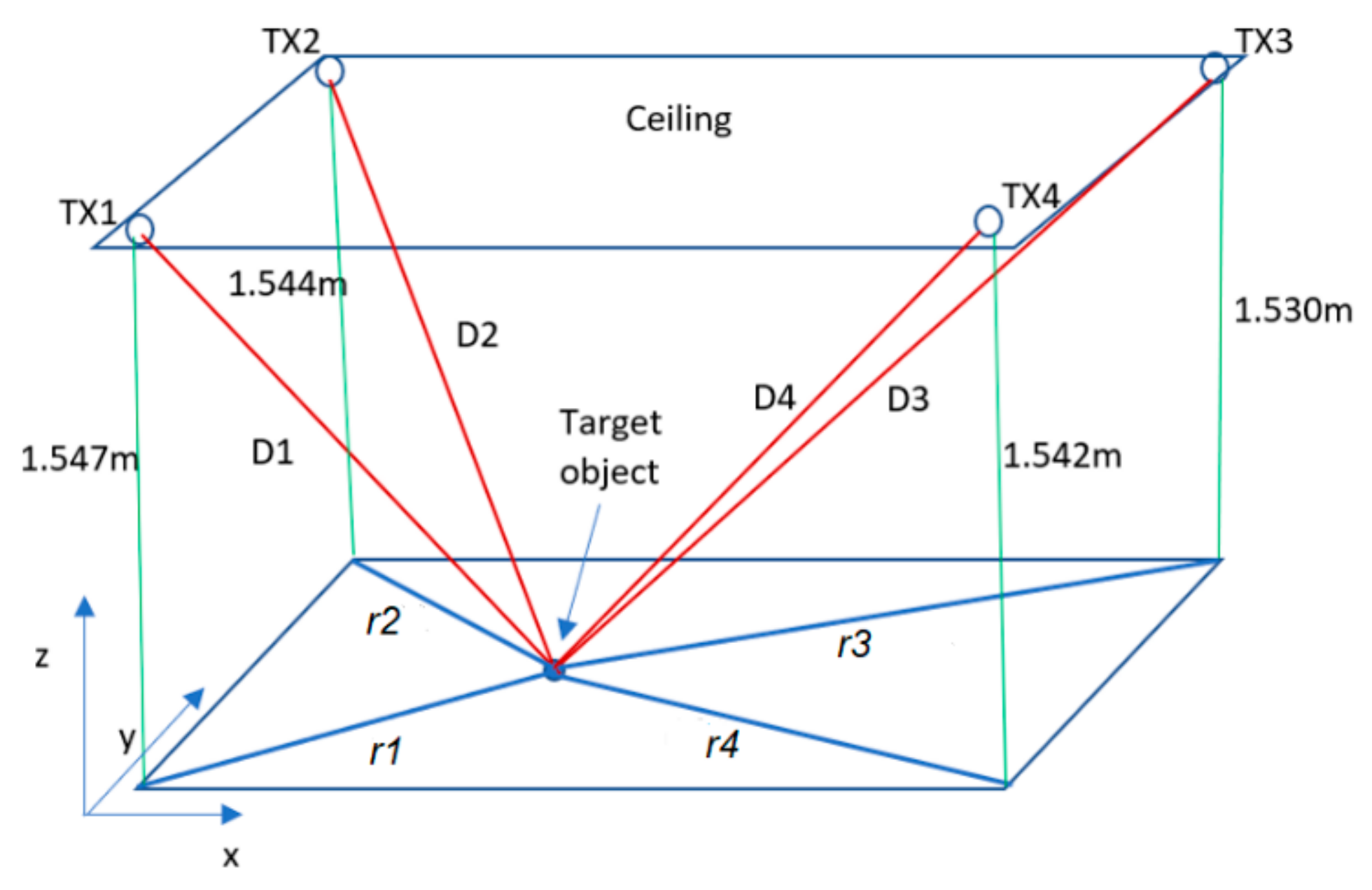
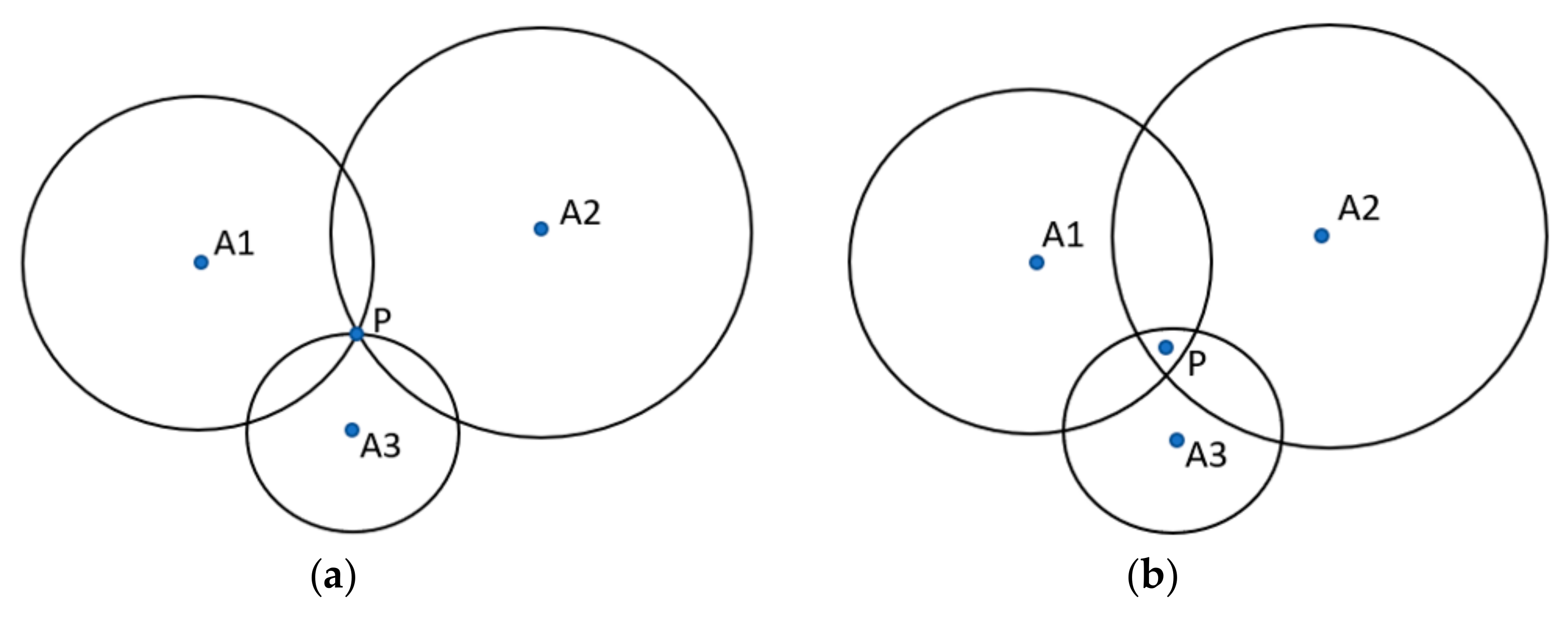
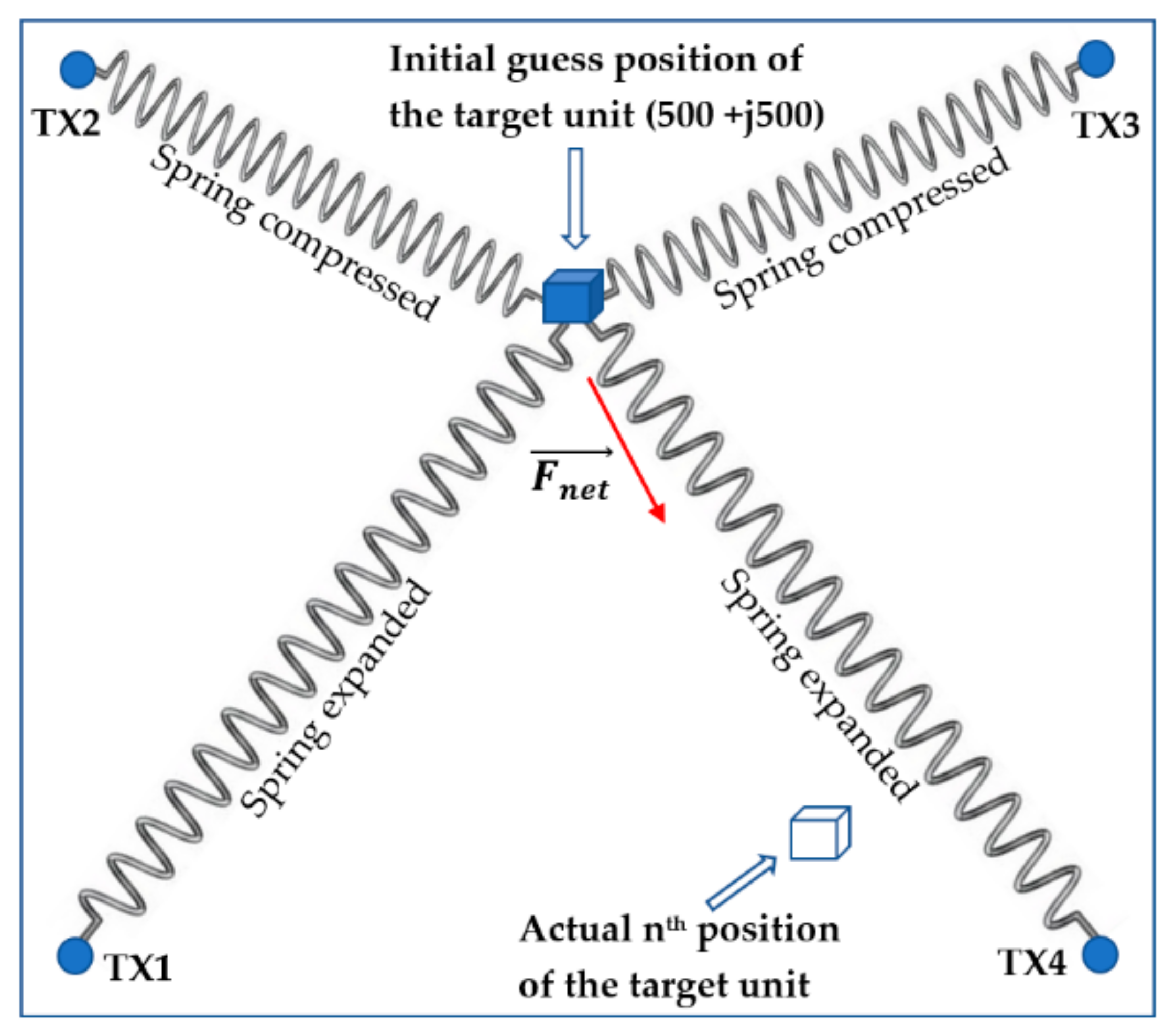
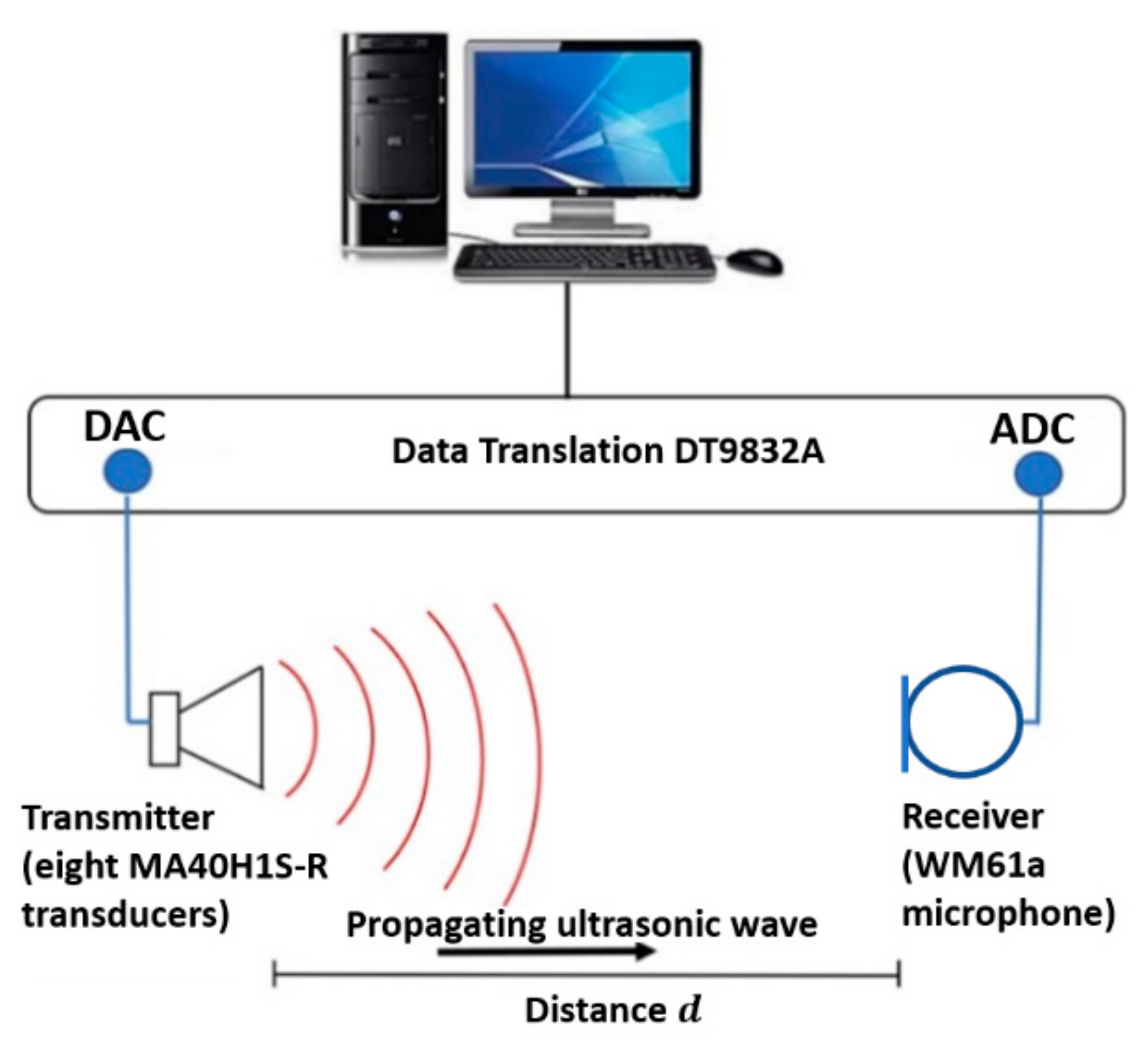
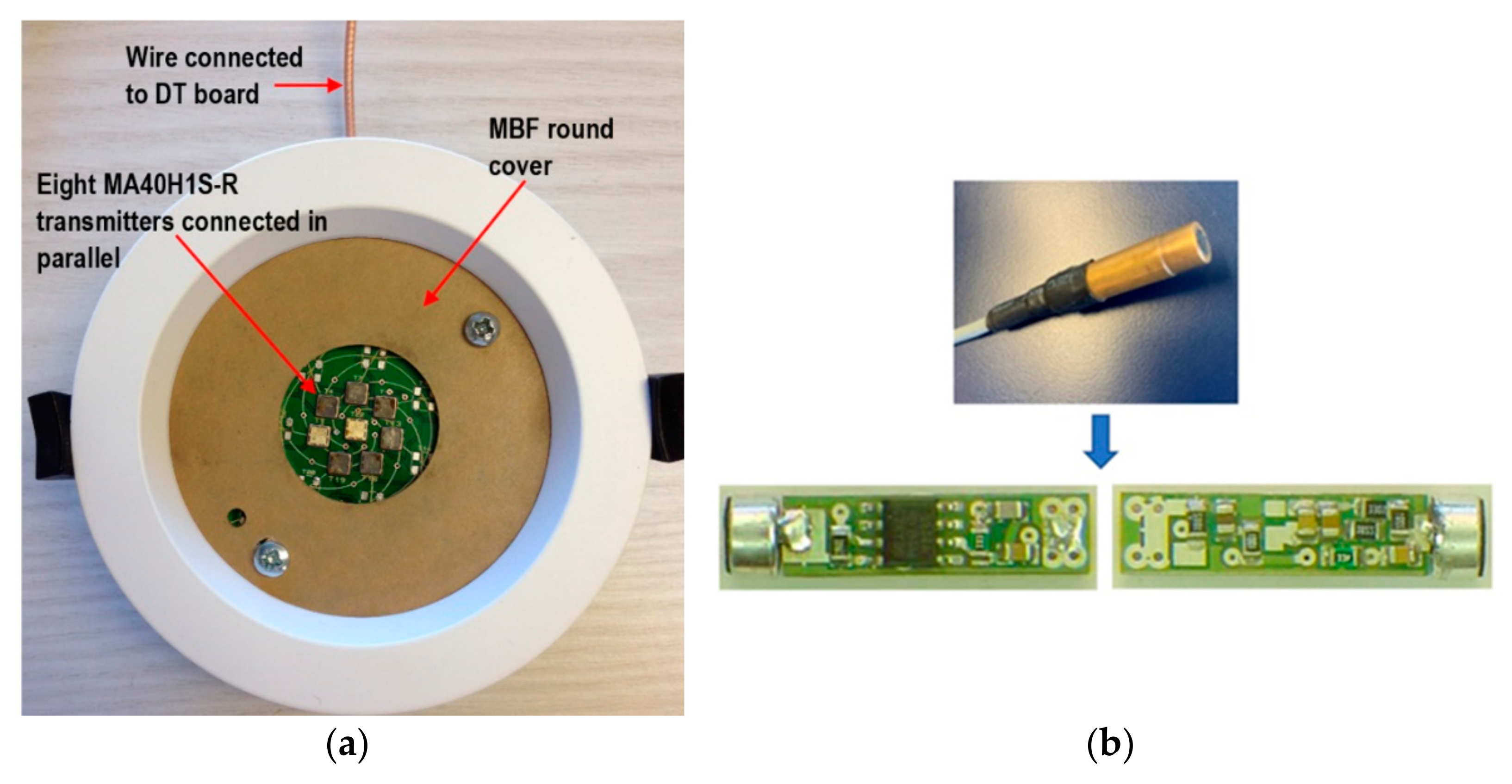
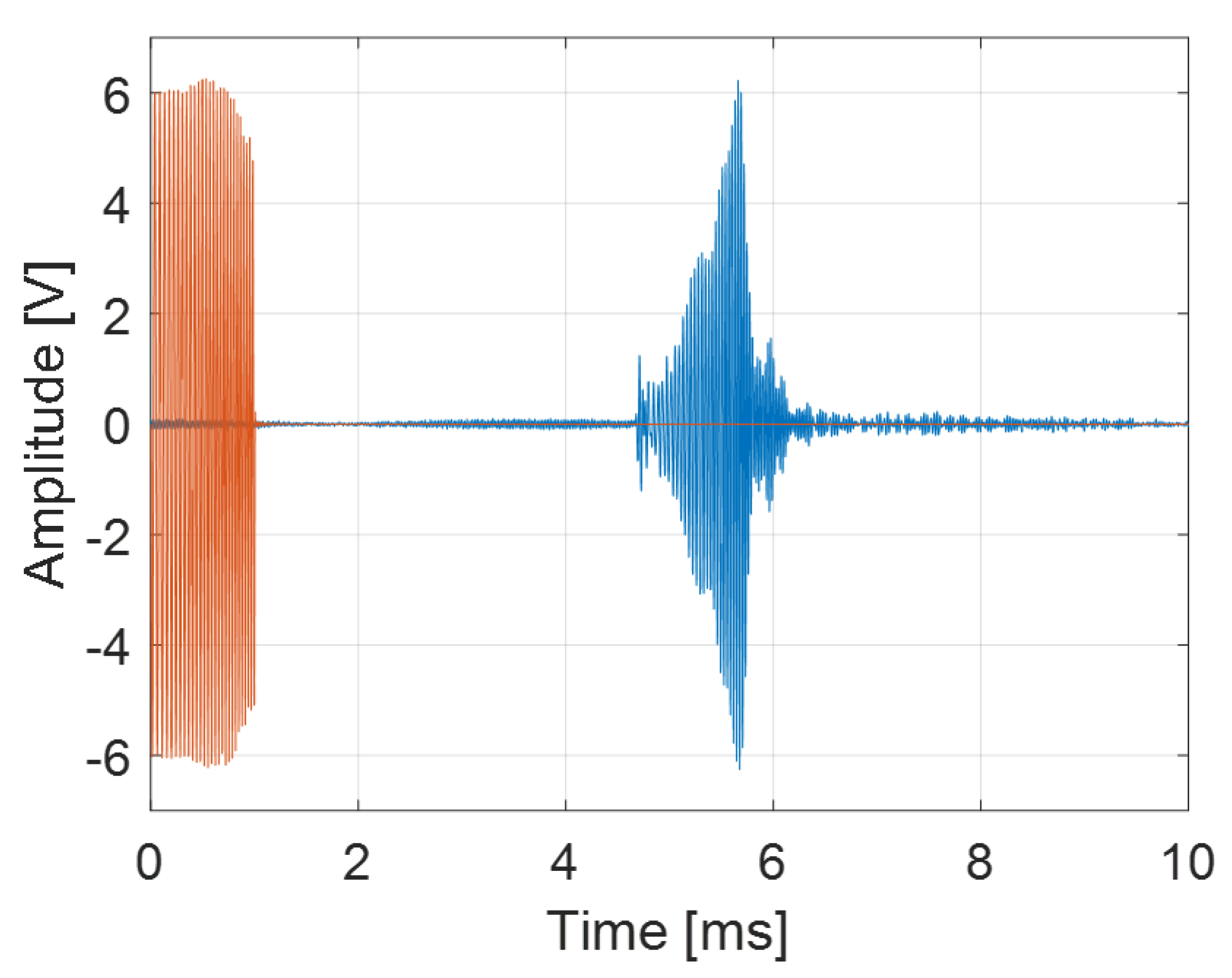

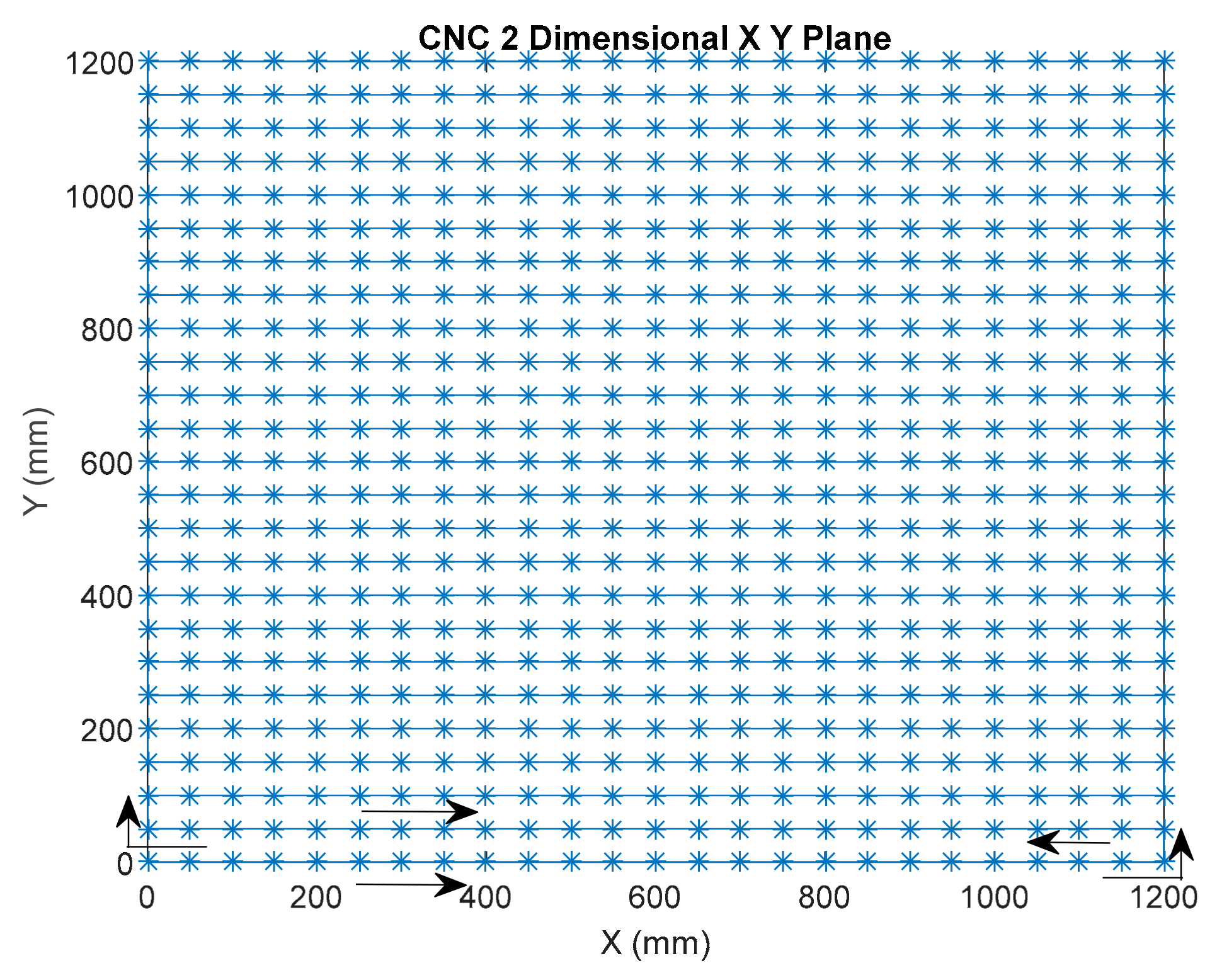
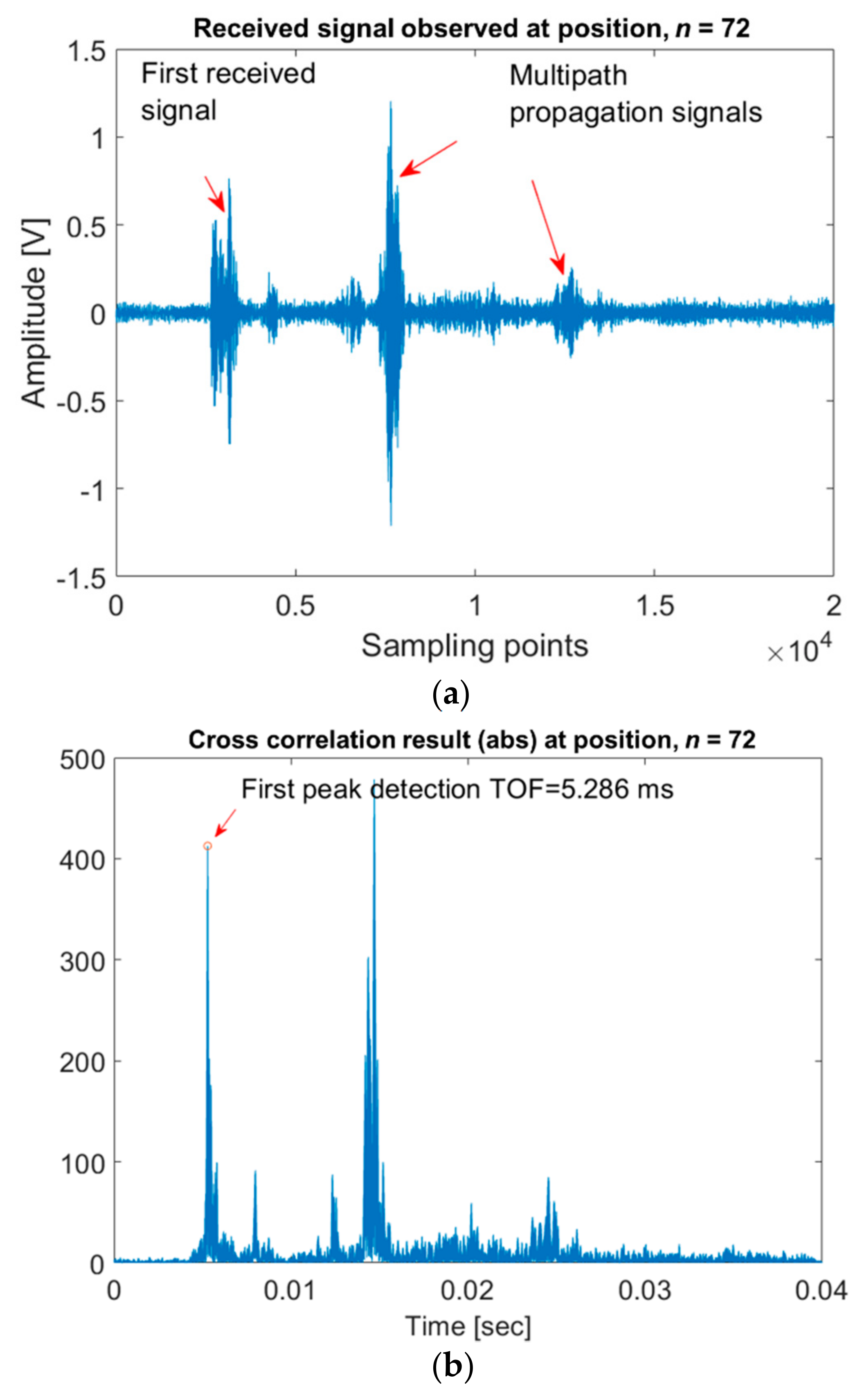
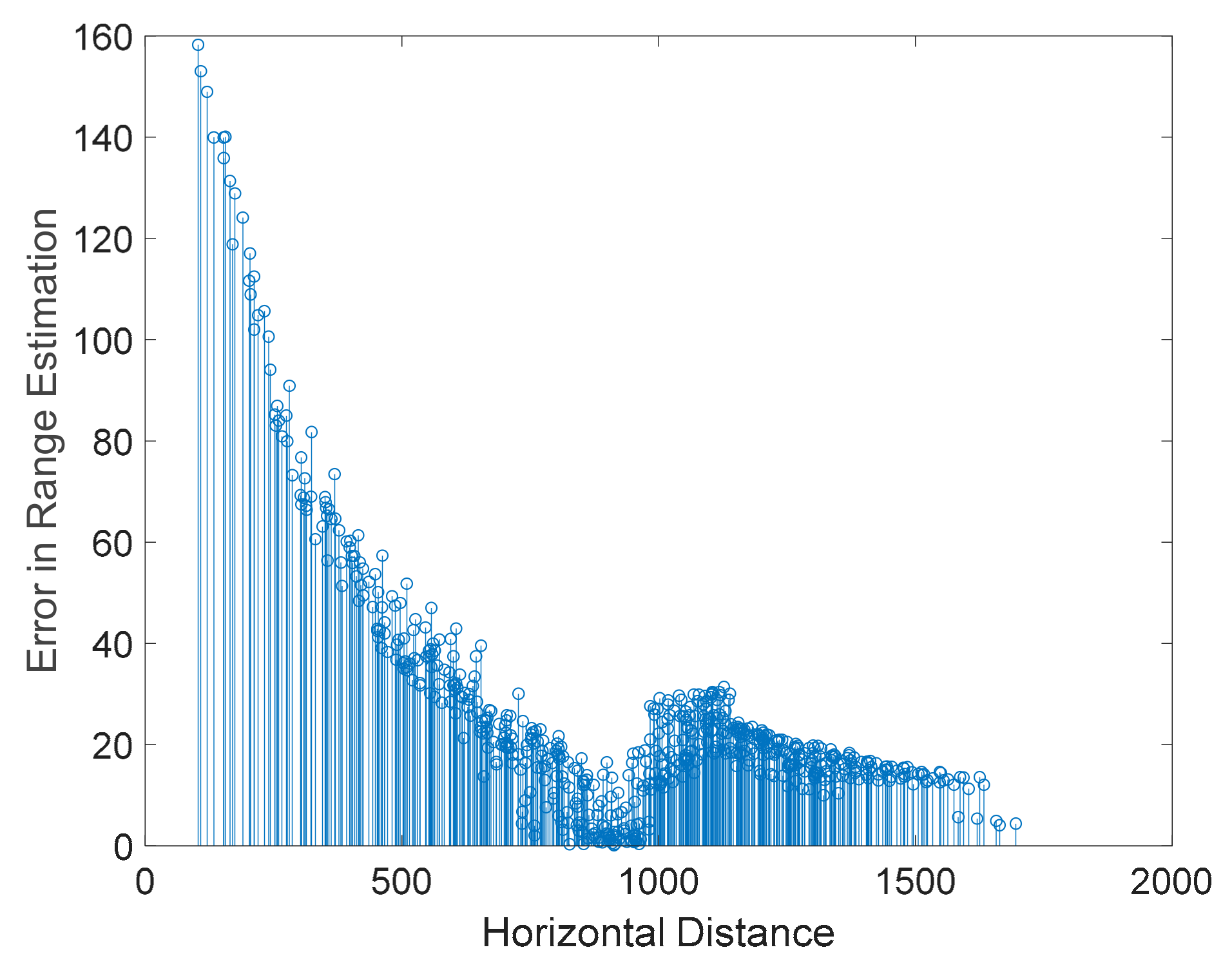
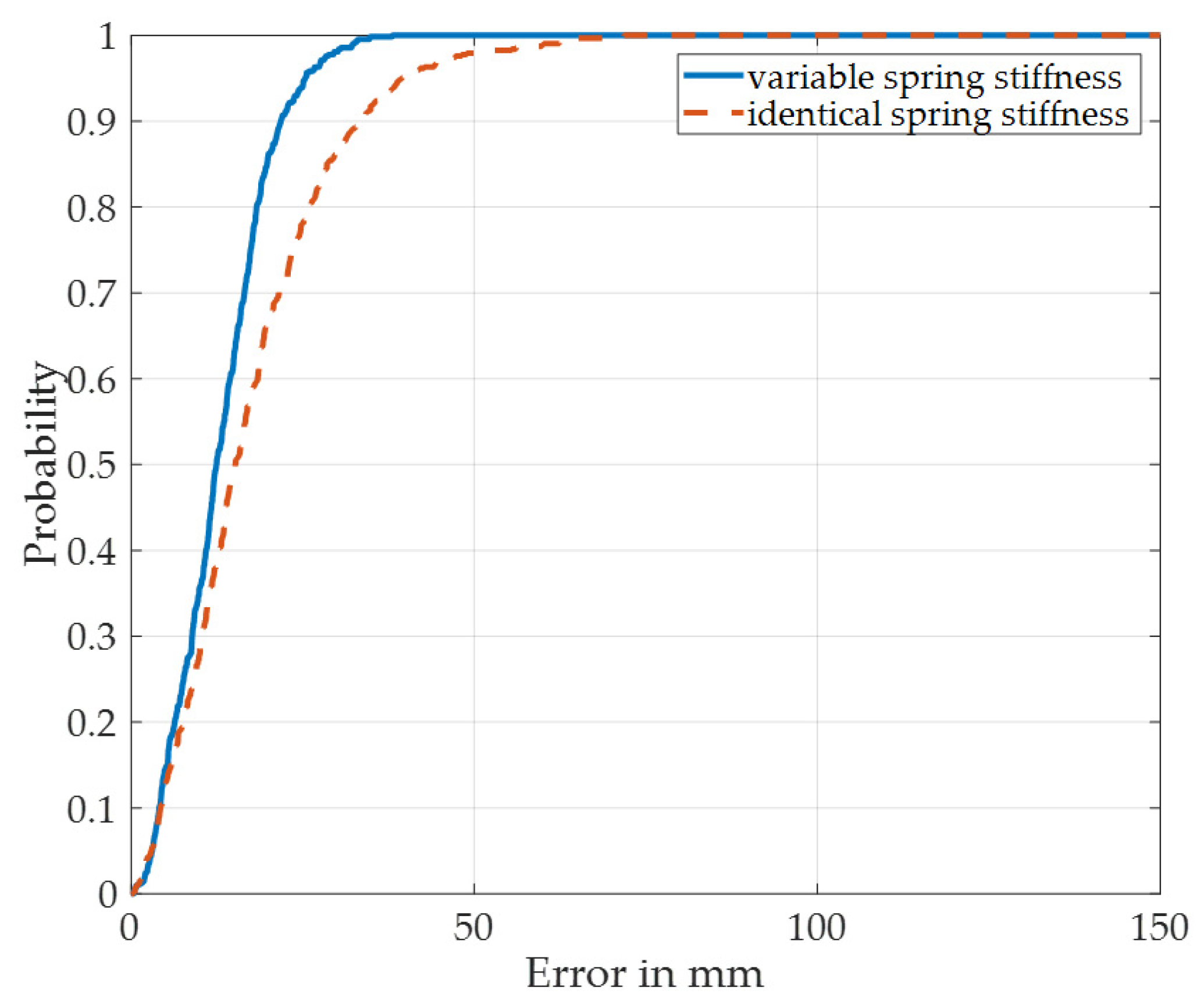

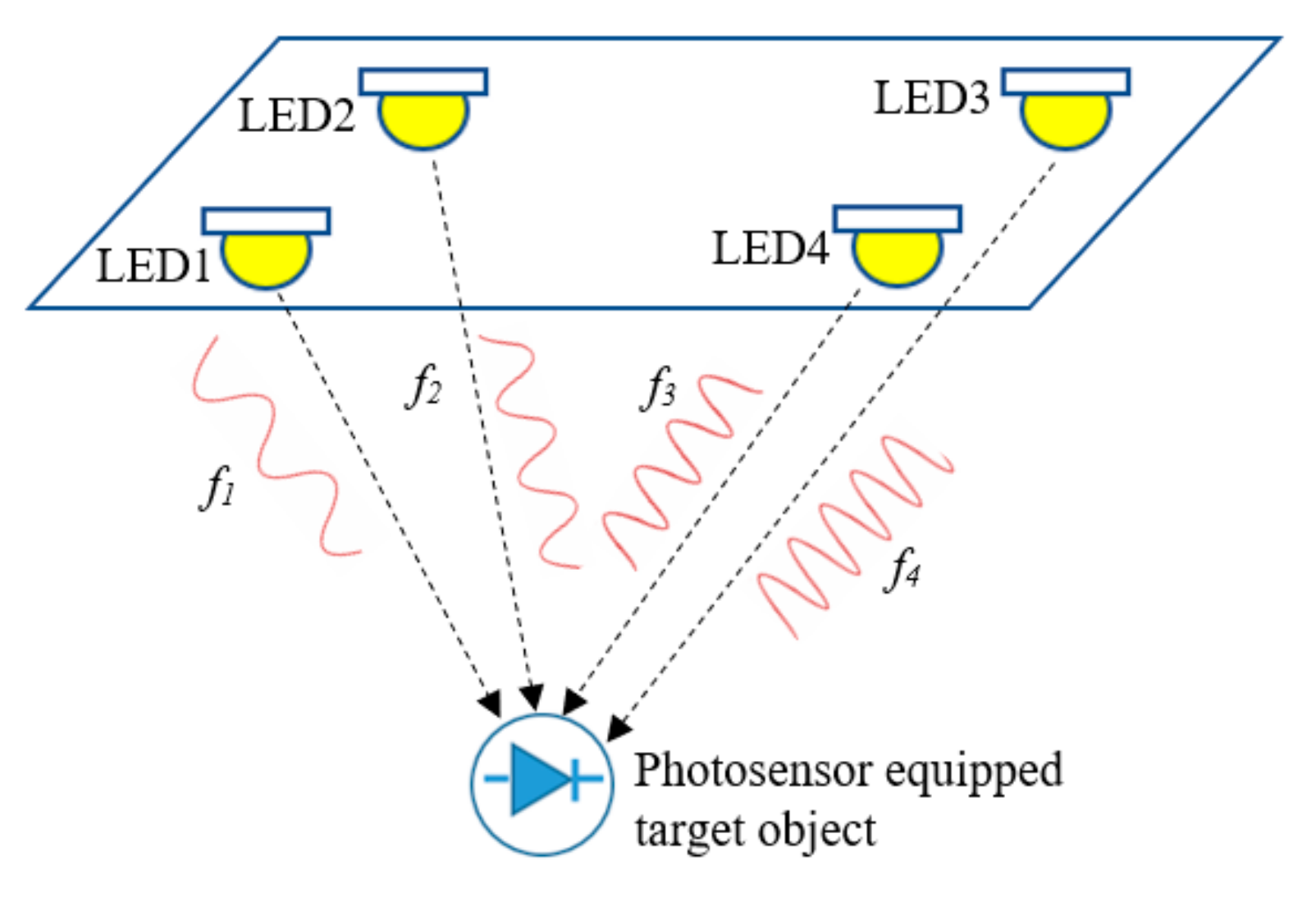
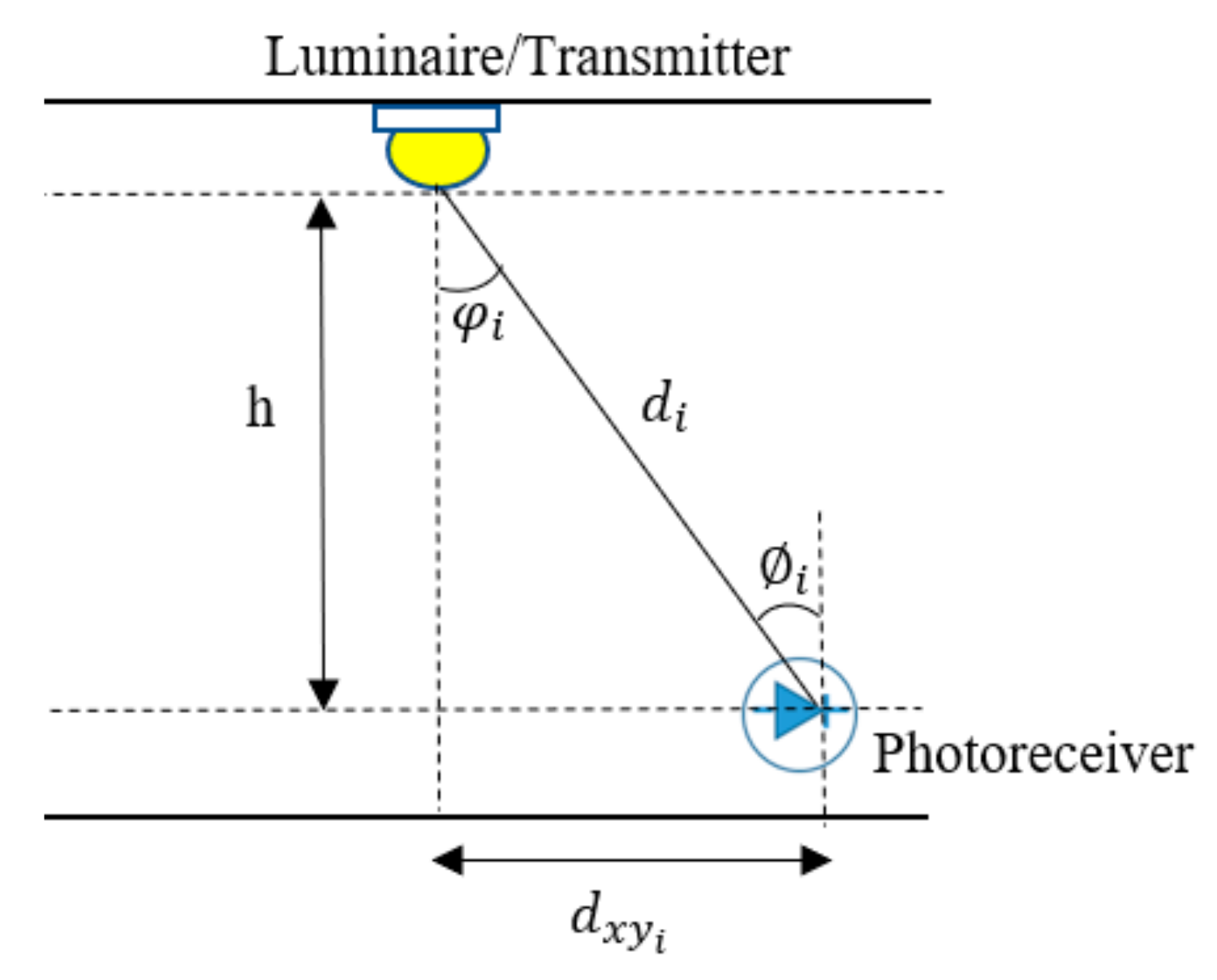
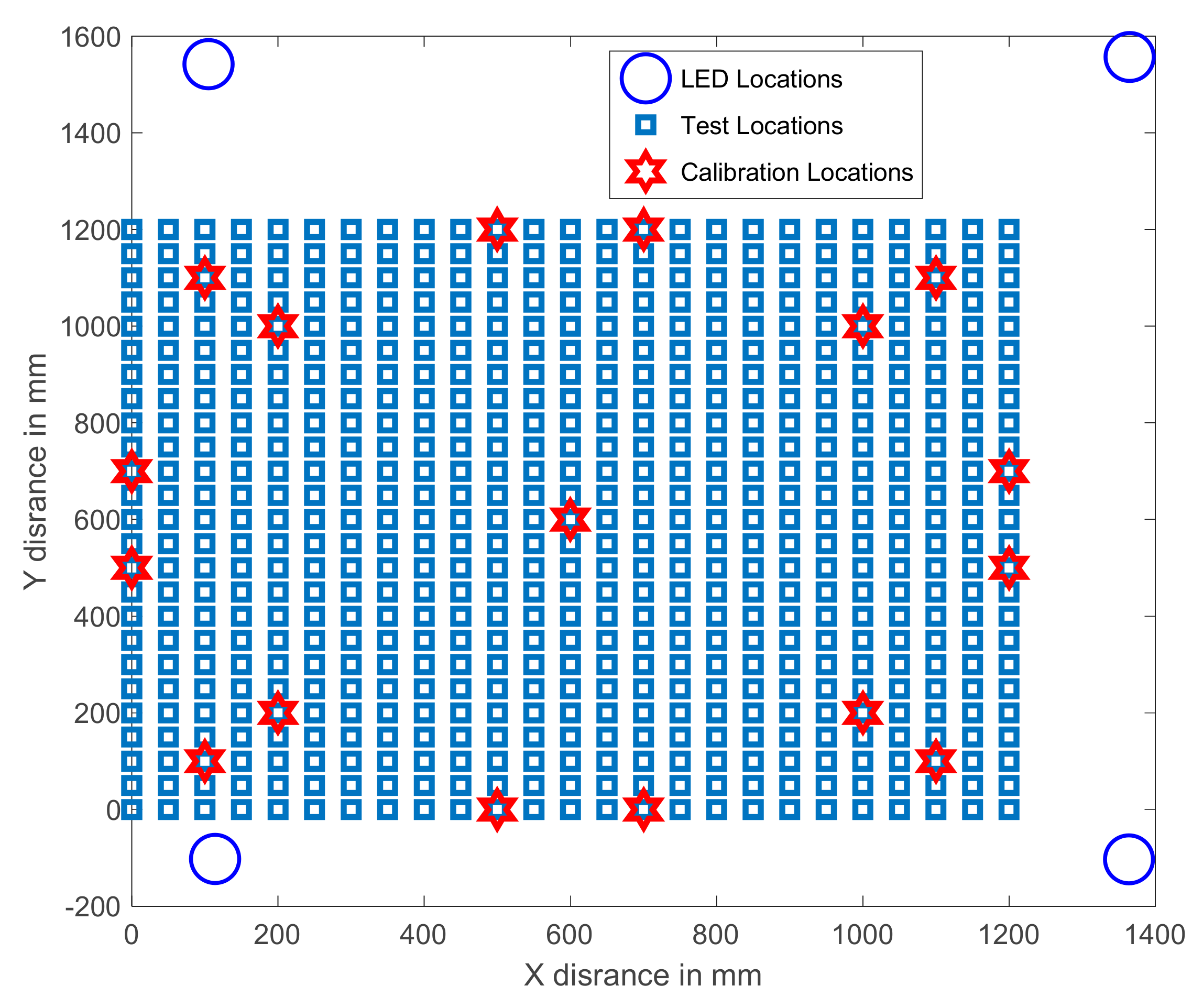
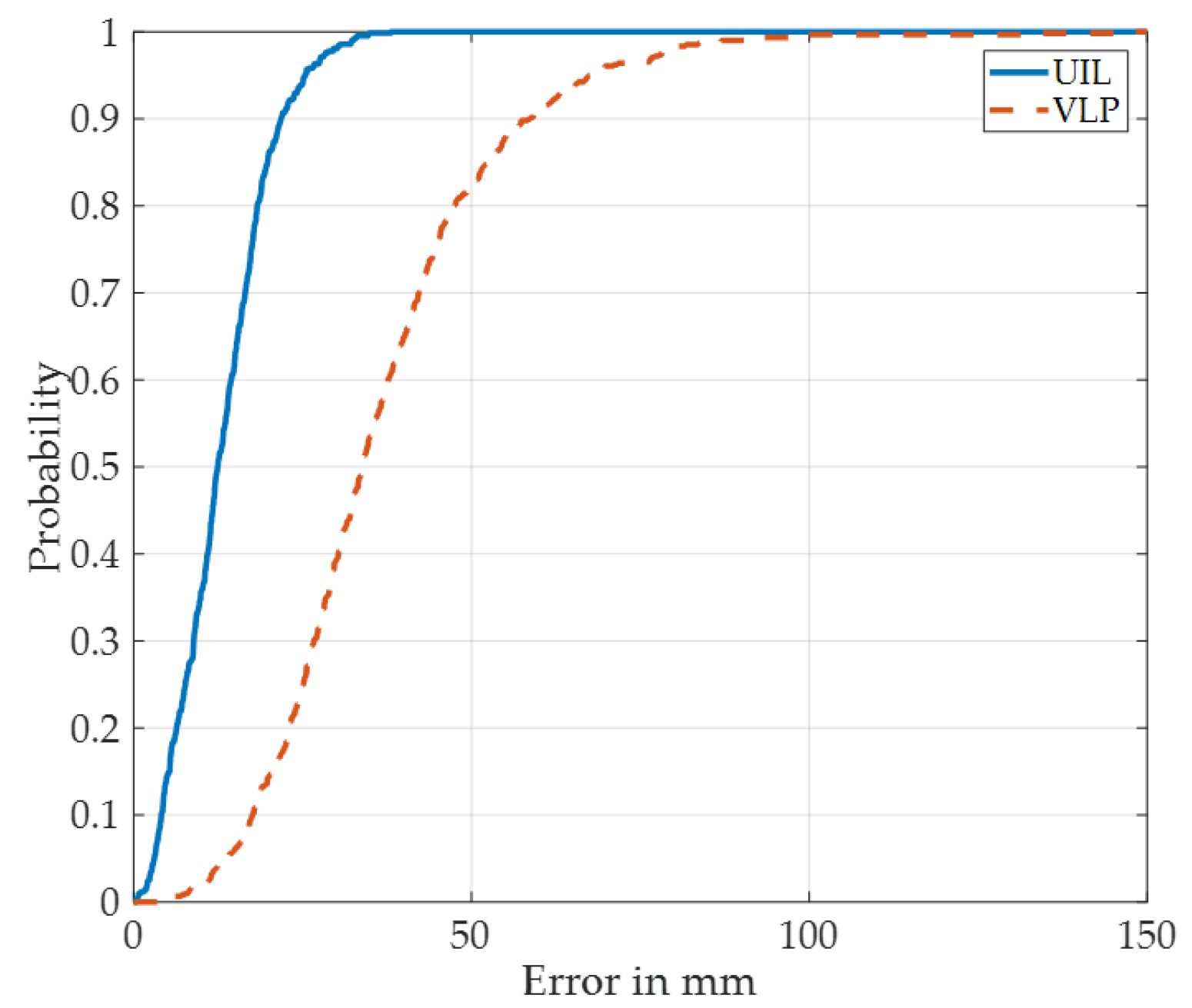
| With Identical Spring Stiffness (no Weighting) | With Variable Spring Stiffness (with Weighting) |
|---|---|
| Median = 15.2 mm Mean error = 17.6 mm 90-percentile = 33.8 mm Std-deviation = 12 mm | Median = 12.4 mm Mean error = 13.0 mm 90-percentile = 21.8 mm Std-deviation = 6.9 mm |
| Lateration | Spring-Relaxation |
|---|---|
| Median = 14.5 mm | Median = 12.4 mm |
| Mean error = 13.8 mm | Mean error = 13.1 mm |
| 90-percentile = 25.9 mm | 90-percentile = 21.8 mm |
| Std-deviation = 8.0 mm | Std-deviation = 6.9 mm |
| UIL | VLP (mm) |
|---|---|
| Median = 12.4 mm | Median = 33.7 mm |
| Mean error = 13.0 mm | Mean error = 36.5 mm |
| 90-percentile = 21. 8 mm | 90-percentile = 58.6 mm |
| Std-deviation = 6.9 mm | Std-deviation = 17.3 mm |
Publisher’s Note: MDPI stays neutral with regard to jurisdictional claims in published maps and institutional affiliations. |
© 2021 by the authors. Licensee MDPI, Basel, Switzerland. This article is an open access article distributed under the terms and conditions of the Creative Commons Attribution (CC BY) license (https://creativecommons.org/licenses/by/4.0/).
Share and Cite
Chew, M.T.; Alam, F.; Legg, M.; Sen Gupta, G. Accurate Ultrasound Indoor Localization Using Spring-Relaxation Technique. Electronics 2021, 10, 1290. https://doi.org/10.3390/electronics10111290
Chew MT, Alam F, Legg M, Sen Gupta G. Accurate Ultrasound Indoor Localization Using Spring-Relaxation Technique. Electronics. 2021; 10(11):1290. https://doi.org/10.3390/electronics10111290
Chicago/Turabian StyleChew, Moi Tin, Fakhrul Alam, Mathew Legg, and Gourab Sen Gupta. 2021. "Accurate Ultrasound Indoor Localization Using Spring-Relaxation Technique" Electronics 10, no. 11: 1290. https://doi.org/10.3390/electronics10111290
APA StyleChew, M. T., Alam, F., Legg, M., & Sen Gupta, G. (2021). Accurate Ultrasound Indoor Localization Using Spring-Relaxation Technique. Electronics, 10(11), 1290. https://doi.org/10.3390/electronics10111290








